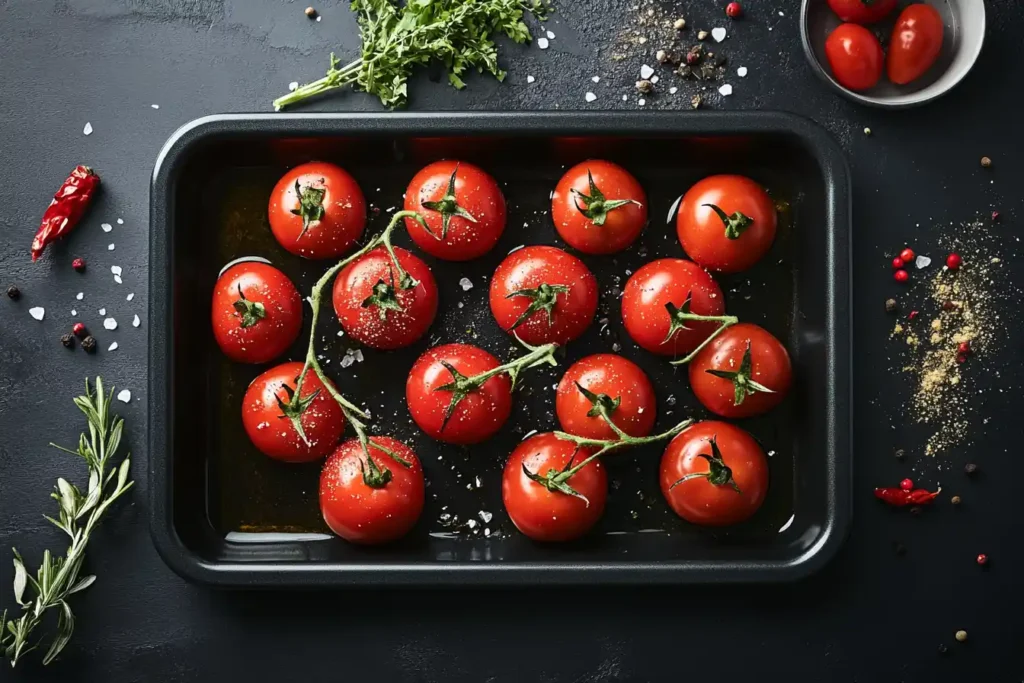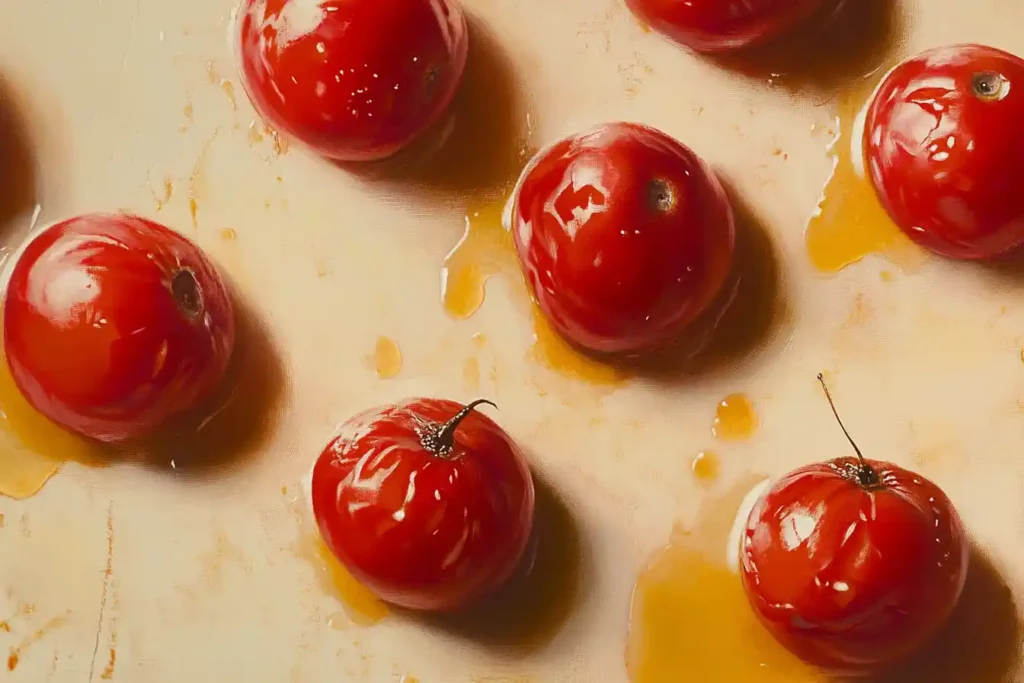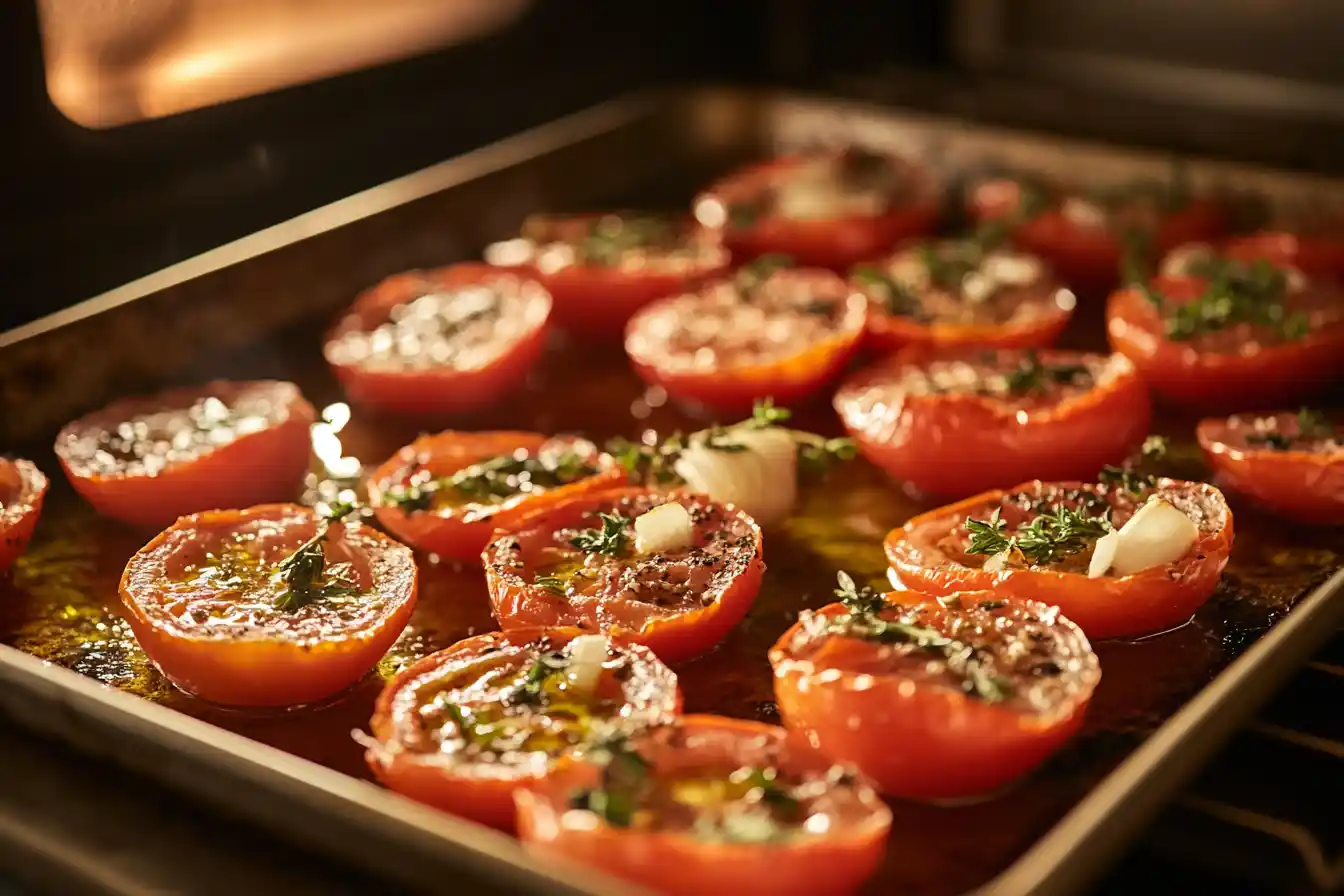Introduction
Roasting tomatoes in the oven is a simple yet flavorful way to enhance their natural sweetness and create a rich, caramelized texture. Whether you’re preparing them for pasta sauces, salads, or soups, oven-roasted tomatoes add depth and complexity to any dish.
But what makes roasting so special? The slow heat draws out excess moisture while concentrating the sugars, giving the tomatoes a richer, almost jam-like flavor. Plus, it’s an easy technique that requires minimal ingredients and effort.
In this guide, we’ll walk you through every step of roasting tomatoes in the oven, from selecting the perfect variety to seasoning and storing them for later use. By the end, you’ll know exactly how to create delicious roasted tomatoes that can transform any meal.
Preparing Tomatoes for Roasting
Choosing the Right Tomatoes
Not all tomatoes are created equal when it comes to roasting. The type of tomato you choose can significantly impact the flavor and texture.
- Cherry and Grape Tomatoes – Ideal for quick roasting due to their small size and naturally sweet flavor.
- Roma Tomatoes – Known for their dense flesh and low moisture content, they roast well and are perfect for sauces.
- Heirloom Tomatoes – These tomatoes provide a unique flavor but may take slightly longer to roast due to their high water content.
- Vine-Ripened Tomatoes – Juicy and flavorful, they work great for roasting whole or halved.
Cleaning and Prepping Tomatoes
Before roasting, always wash the tomatoes thoroughly under running water to remove dirt and pesticides. For organic tomatoes, a quick rinse is usually sufficient.
- Step 1: Remove stems and any damaged spots.
- Step 2: Pat them dry with a clean towel to ensure the seasonings stick properly.
Cutting Techniques for Roasting
- Whole Roasting: Leave cherry or grape tomatoes intact for a burst of flavor when roasted.
- Halved Roasting: Slice Roma or vine-ripened tomatoes in half for faster cooking and caramelization.
- Quartered or Sliced Roasting: Perfect for larger tomatoes or if you want thinner slices for layering in dishes.
Seasoning Options for Roasted Tomatoes

Classic Seasoning Combinations
Simple seasonings can highlight the natural flavors of tomatoes without overpowering them.
- Olive oil, salt, and black pepper – The foundation for any roasted tomato recipe.
- Garlic powder or minced garlic – Adds depth and aroma.
- Italian seasoning – A blend of basil, oregano, and thyme for a Mediterranean touch.
Creative Flavor Enhancements
Want to experiment? Try these combinations for a twist:
- Spicy Kick: Crushed red pepper flakes and smoked paprika.
- Savory Depth: Balsamic vinegar drizzle for tanginess and sweetness.
- Cheesy Flavor: Grated Parmesan or crumbled feta added in the last 5 minutes of roasting.
Using Fresh vs. Dried Herbs
Fresh herbs like basil, rosemary, or thyme can be sprinkled on before roasting for a vibrant flavor. Alternatively, dried herbs offer a more concentrated taste and work well when combined with olive oil.
Oven Temperature and Roasting Techniques
Best Temperature for Roasting Tomatoes
The temperature you choose plays a big role in how your tomatoes turn out. For most recipes, 375°F (190°C) to 425°F (220°C) is ideal:
- Low and Slow (375°F) – Produces tender tomatoes with deep, rich flavors, perfect for sauces and spreads.
- High Heat (425°F) – Ideal for quick roasting when you need caramelized edges and slightly crispy skins.
Baking Sheet or Oven Dish: Which to Use?
- Baking Sheet: Best for achieving even roasting. Spread the tomatoes in a single layer without overlapping to allow hot air to circulate.
- Oven-Safe Dish: Suitable for juicier results, especially when you want to capture the flavorful juices for sauces or soups.
Pro Tip: Line your pan with parchment paper for easy cleanup and to prevent sticking.
Achieving Even Roasting and Caramelization
- Drizzle Generously: Use high-quality olive oil to coat the tomatoes. This helps prevent drying out and promotes even caramelization.
- Toss Thoroughly: Mix the tomatoes with oil and seasonings in a bowl before spreading them out.
- Flip or Stir Midway: For uniform roasting, stir or flip the tomatoes halfway through the cooking time.
Cooking Times Based on Tomato Types

Roasting Cherry and Grape Tomatoes
- Temperature: 400°F (205°C)
- Time: 20–25 minutes
- Notes: These small tomatoes roast quickly and burst open when done, creating a juicy texture.
Roasting Large or Roma Tomatoes
- Temperature: 375°F (190°C)
- Time: 30–40 minutes
- Notes: Halving them speeds up roasting and concentrates the flavors.
Adjusting Time for Halved vs. Whole Tomatoes
- Whole Tomatoes: Require slightly longer roasting times, especially for larger varieties.
- Halved or Quartered Tomatoes: Roast faster and are ideal for creating a more intense flavor profile.
Tip: Always keep an eye on the oven, as smaller tomatoes can burn quickly at high heat.
Storing and Using Roasted Tomatoes
Short-Term Storage Methods
- Refrigerator: Store roasted tomatoes in an airtight container for up to 5 days.
- Olive Oil Preservation: Submerge the roasted tomatoes in olive oil to keep them moist and flavorful.
Freezing for Long-Term Preservation
- Step 1: Allow roasted tomatoes to cool completely.
- Step 2: Spread them in a single layer on a baking sheet and freeze until firm.
- Step 3: Transfer to freezer bags or containers. They can last up to 6 months.
Culinary Uses for Roasted Tomatoes
- Pasta Sauces: Blend roasted tomatoes with garlic and herbs for a quick marinara sauce.
- Salads: Toss them into grain bowls, caprese salads, or mixed greens.
- Pizza Toppings: Add depth to homemade pizzas or flatbreads.
- Soups and Stews: Use as a flavorful base for tomato soups or hearty stews.
- Sandwiches and Bruschetta: Spread roasted tomatoes over crusty bread or sandwiches for extra zest.
Common Mistakes to Avoid When Roasting Tomatoes
Overcrowding the Pan
One of the most common errors when roasting tomatoes is overcrowding the baking sheet. If the tomatoes are too close together, they’ll steam instead of roast.
- Solution: Arrange the tomatoes in a single layer with space between them. This allows the heat to circulate evenly, ensuring proper caramelization.
Over- or Underseasoning
Another pitfall is either adding too little or too much seasoning. Underseasoning results in bland flavors, while overseasoning can overpower the natural sweetness of the tomatoes.
- Solution: Start with a light sprinkle of salt and pepper, then taste and adjust after roasting. Remember, you can always add more seasoning later, but you can’t remove it once added.
Burning vs. Roasting: How to Avoid Burnt Edges
At high temperatures, tomatoes can quickly burn, especially smaller varieties like cherry or grape tomatoes. Burnt tomatoes lose their sweetness and develop a bitter taste.
- Solution: Monitor the roasting process closely and rotate the pan halfway through cooking. If needed, lower the oven temperature during the last few minutes of roasting.
Not Using Enough Oil
Olive oil is crucial for proper roasting, as it prevents tomatoes from drying out while helping seasonings adhere to their surface.
- Solution: Coat the tomatoes evenly with oil, ensuring all sides are covered, but avoid drenching them. About 1–2 tablespoons per pound of tomatoes is sufficient.
Health Benefits of Roasted Tomatoes
Nutritional Value Retention During Roasting
Roasting tomatoes enhances their flavor without stripping them of essential nutrients. Tomatoes are packed with vitamins C and K, potassium, and folate, making them a healthy addition to any meal.
- Vitamin C: Supports immune function and skin health.
- Potassium: Helps regulate blood pressure and heart function.
- Fiber: Aids digestion and promotes gut health.
Lycopene and Antioxidant Benefits
Tomatoes are rich in lycopene, a powerful antioxidant known for reducing inflammation and supporting heart health. Interestingly, cooking tomatoes increases the bioavailability of lycopene, making roasted tomatoes even healthier than raw ones.
- Anti-Cancer Properties: Lycopene may help lower the risk of certain cancers, including prostate and lung cancer.
- Skin Protection: Acts as a natural sunblock, protecting skin from UV damage.
- Heart Health: Helps reduce cholesterol and improve blood vessel function.
Low-Calorie, High-Nutrient Snack
Roasted tomatoes are naturally low in calories, making them an excellent choice for weight management. Plus, their rich flavor and satisfying texture make them a great alternative to processed snacks.
Frequently Asked Questions (FAQs)
1. Can you roast frozen tomatoes?
Yes, frozen tomatoes can be roasted, but they should be thawed first for better seasoning absorption. Once thawed, pat them dry before adding oil and spices.
2. Should you peel tomatoes before roasting?
No, peeling is not necessary. The skins crisp up during roasting, adding texture and flavor. However, if you prefer smoother sauces, you can peel them after roasting.
3. How long do roasted tomatoes last in the fridge?
Properly stored in an airtight container, roasted tomatoes can last 4–5 days in the refrigerator. For longer storage, freeze them for up to 6 months.
4. What oils work best for roasting tomatoes?
Extra virgin olive oil is the most popular choice due to its rich flavor and health benefits. Alternatively, avocado oil or grapeseed oil can be used for higher-heat roasting.
5. Can roasted tomatoes be used in pasta sauce?
Absolutely! Roasted tomatoes add a smoky depth to pasta sauces. Simply blend them with garlic, basil, and olive oil for a homemade marinara.
6. Do you need to flip tomatoes while roasting?
It’s not required, but flipping halfway through ensures even roasting and prevents burning, especially for halved tomatoes.
Looking for more tomato recipes? Check out our guide on Roasted Tomatoes for Pasta Sauce for delicious ideas. Curious about the difference between roasting and boiling tomatoes? Read our article on Roast vs Boil Tomatoes for Sauce. For flavor tips, discover What Does Roasting Tomatoes Do to the Flavor?.
Conclusion
Roasting tomatoes in the oven is a simple yet transformative cooking technique that brings out their natural sweetness and rich flavors. Whether you’re using cherry, Roma, or heirloom tomatoes, the process is versatile and can be customized with various seasonings and herbs to suit your taste preferences.
By following the steps outlined in this guide—selecting the right tomatoes, properly seasoning, and roasting at the ideal temperature—you can create delicious, caramelized tomatoes that add depth and flavor to a wide range of dishes. From pasta sauces and soups to salads and sandwiches, roasted tomatoes are a culinary staple worth mastering.
We’ve also covered tips to avoid common mistakes, proper storage methods, and the nutritional benefits that make roasted tomatoes both a tasty and healthy addition to your diet.
So, preheat your oven, grab your favorite tomatoes, and start roasting! With just a little effort, you’ll have a kitchen staple that’s bursting with flavor and ready to elevate any meal.

